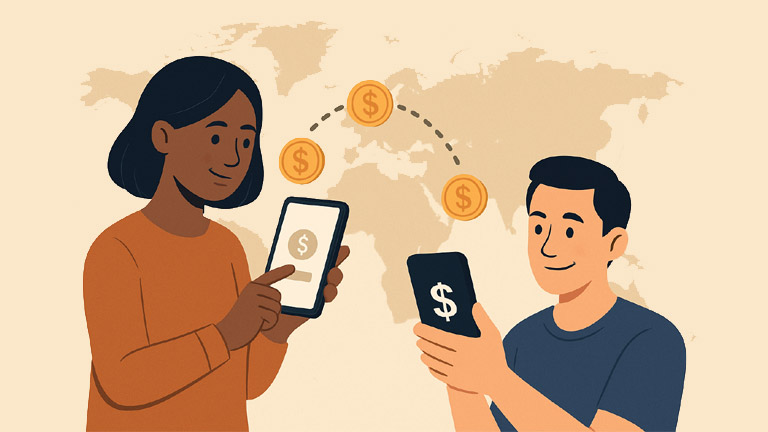
In today’s global age, sending money abroad for education, business, or to help family has become common. But when your currency has to be converted into dollars, euros, pounds, or any other currency, banks and exchange houses charge hefty conversion fees. This reduces the value of the money sent. At times, you may think, “Why not send that currency directly so that there is no need for conversion?” Actually, it is possible. There are certain ways in which you can send money abroad directly without conversion. Let us understand these methods in detail.
Forex Bank Accounts and Multi-Currency Solutions
The simplest way is to open a bank account in a foreign currency. If you have an account in a foreign currency (such as US dollars), then you can send money directly from that account in the same currency. For example, if you have an account in USD in a bank in the US, you can have a savings account in dollars in India, and you can transfer directly to the same currency account in the US. This will avoid any conversion. According to experts, if you frequently make payments in foreign currency (such as CAD, GBP, or EUR), then you should open a separate account in that currency. It is also valuable for those whose business clients or most transactions are in a particular country.
This way, the bank will not have to convert from rupees to another currency, and you will be able to avoid the hidden exchange charges of the bank. In fact, many new-age fintech companies offer multi-currency accounts. In such services, you can keep balances in more than 50 currencies within a single account. You get local bank account details for Britain, the Eurozone, Australia, New Zealand, the US, etc., making it easy to receive and send payments in these currencies. Transactions in these accounts are done at the mid-market exchange rate, and there is no additional foreign transaction fee.
Not only this, there is a transparent nominal fee on every transaction sent from these accounts; there are no hidden charges. For example, a report says that it is necessary to have a ‘foreign currency account’ to invest in foreign stocks or assets. If there is no account, then every time one has to convert from one currency to another, due to a huge amount being paid as ‘exchange cost.’ On the other hand, in a multi-currency account, there is usually no additional charge on new payments, which can save up to 75% in foreign exchange expenses. Apart from this, under the RBI’s Liberalized Remittance Scheme (LRS) in India, you can send foreign investment or aid up to ₹ 2.5 lakh annually. That is, money can also be sent in foreign currency up to this limit.
Digital wallet and online payment services
Apart from banks, many online wallets and payment platforms support multi-currency. For example, in a digital wallet like PayPal, you can keep balances in different currencies. You can add a new currency to your wallet or change the primary currency. If a payment comes from abroad in another currency, it accepts your wallet in that currency and opens a separate balance for that currency. With this, you can keep or send that amount without conversion. Similarly, platforms like Wise (formerly TransferWise) let you store and send money in multiple currencies; local account details for multiple countries are available, so you can make payments anywhere in the world with ease. These services convert money at the mid-market exchange rate and charge transparent fees.
Let’s take an example from these digital solutions: Let’s say your friend is in the US and you need to send him money. Your best bet is to send money in US dollars and transfer dollars from your bank. There is no intermediate currency conversion. You can also transfer dollars in the same currency as you would in a digital wallet. This way, you won’t have to pay the inflated exchange rate of banks, nor will there be the hassle of conversion to rupees.
Cryptocurrency and Stablecoin Options
A newer and faster option is cryptocurrencies, especially stablecoins. Stablecoins (such as USDT, USDC, and DAI) are basically pegged to the dollar or another stable currency. Their advantages are that they transfer in minutes, and the fees are very low. These allow transfers of money in seconds, bypassing traditional banks. For example, many Indian and Argentinian freelancers receive payments from overseas clients in USDT. This ensures instant transactions, and there are no hidden foreign currency charges.
Similarly, migrant workers and NGOs around the world are using stablecoins, as they do not have the fees associated with the banking system, and the rates are clear. However, when choosing a crypto option, keep in mind that the recipient should also have a crypto wallet. You may have to re-exchange to withdraw the money in local currency, which is a separate process. Despite this, using stablecoins has proven to be very beneficial—they run at transparent rates and are free from intermediary bank fees.
Precautions and rules
These methods also require some caution when sending money. First, follow banking rules and tax laws. For example, foreign transactions of up to $2.5 lakh per year can be done in India under the RBI’s LRS scheme. Special permission is required to send more than this. Some places may levy taxes (such as TCS) on money sent abroad, so keep the receipt and documents safe.
Secondly, always choose a trusted medium. Whatever account details you enter on any digital platform should be correct. Do not share your credit/debit card and wallet password OTP with others. Before sending money to an anonymous person, do thorough research to ensure that they have given trusted account details.
Finally, while looking for a facility, look at the different rates of bank accounts. Many banks charge fewer fees for small transactions but impose a markup on large remittances. Knowing this will help you avoid converting currency again and paying fees. Always choose a rate close to the mid-market exchange rate and disclose the fees.
Bottom line
If you can use the same currency when sending money abroad, you can save on currency conversion. To do this, open a foreign currency bank account or a multi-currency account. You can also hold multiple currency balances in a digital wallet (such as PayPal or Wise). Technologies such as stablecoins offer a faster, cheaper way. Transferring money this way keeps the money saved in your pocket. By being careful with these methods and having the right information, you can send money abroad without additional conversion fees and save valuable money.


